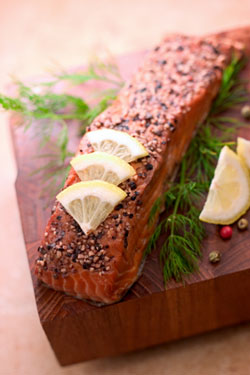 
A favorite way to enjoy smoked salmon of any kind: on a bagel. Photo courtesy MackenzieLtd.com.
|
KAREN HOCHMAN is Editorial Director of THE NIBBLE.
|
|
March 2007
Updated March 2009
|
 |
The Different Types Of Smoked Salmon
Page 2: Cold Smoked Salmon vs. Hot Smoked Salmon
This is Page 2 of a four-page article. Click on the black links below to visit other pages.
Cold Smoked Versus Hot Smoked Salmon
Our main focus is cold smoked salmon, the category of translucent, non-cooked fish. When looking at packages, especially online, it’s easy to confuse cold smoked with hot smoked salmons. Sellers often don’t distinguish between the two in their descriptive copy. You may think you’re ordering cold smoked salmon, expecting a Nova Scotia or Scottish salmon, only to receive hot smoked salmon. While hot smoked is delicious, it’s quite different from cold smoked.
- Hot smoked salmon produces a thoroughly cooked fish, by smoking it from 6 to 12 hours at temperatures ranging from 120° to 180°F.* Since it is cooked salmon, it is eaten like
 any other cooked salmon, but can be used in most of the same preparations as cold smoked salmon. To the untrained eye, some hot smoked preparations can look the same as cold smoked in the package (some are smoked more lightly, so they still retain some translucency). Up close, the flesh is somewhat to fully opaque and it flakes, like cooked fish. Generally, hot smoking involves holding the food directly above the fire, or in an enclosure that is heated by the fire (barbecue is a form of hot smoking). The temperatures reached in hot smoking can kill microbes in the food. any other cooked salmon, but can be used in most of the same preparations as cold smoked salmon. To the untrained eye, some hot smoked preparations can look the same as cold smoked in the package (some are smoked more lightly, so they still retain some translucency). Up close, the flesh is somewhat to fully opaque and it flakes, like cooked fish. Generally, hot smoking involves holding the food directly above the fire, or in an enclosure that is heated by the fire (barbecue is a form of hot smoking). The temperatures reached in hot smoking can kill microbes in the food.
Presentation: Hot smoked salmon is sold in fillets, but you can get a 20-ounce fillet that looks like a “side.” If it’s in a decorative box, in a gift basket or on a shelf (i.e., not refrigerated), it’s hot smoked salmon. See Page 4 for the different types of hot smoked salmon.
Longevity: Hot smoked salmon can be packaged to have an unrefrigerated shelf life of up to 5 years. It is great to keep in the pantry for an impromptu meal or hors d’oeuvres for unexpected guests.
Photo of hot smoked salmon by Kelly Cline | IST.
- Cold smoked salmon must be refrigerated. First, the fish are filleted and the sides are covered in a layer of salt for up to six hours to cure. The salt draws out moisture, prevents the growth of bacteria, kills microbes and flavors the fish (ham and bacon are also salt cured). The fish can then be dried for several hours before cold smoking, a slow process at a low temperature: 70°F to 90°F for one day to three weeks. The food is not held over the fire as in hot smoking; but rather, smoke is passed by food which is held in a separate area from the fire. Since the fish is not cooked, the interior texture of the food generally isn’t affected: The fish remains smooth.
Presentation: Cold smoked salmon is sold sliced or in sides. It can be sliced to order at a deli counter, or sold vacuum packed in see-through packaging. If it’s in a refrigerated case, it’s cold-smoked salmon (unless it was put there accidentally).
Longevity: Cold smoked salmon is perishable and must be consumed within a couple of weeks if hand-cut, longer if vacuum-packed.
- Use. While the texture and flavor is different, both cold smoked and hot smoked salmon can be used for the same purpose: on bagels and sandwiches, in salads, in pasta, on hors d’oeuvres and in other recipes.
*With both processes, the length of time and degree of temperature depend on the size of the fish, how close it is to the source of smoke and the degree of flavor desired.
Continue To Page 3: Cold Smoked Salmon
Go To The Article Index Above
Lifestyle Direct, Inc. All rights reserved. Images are the copyright of their individual owners.

|
| |